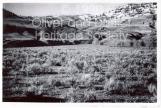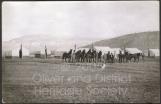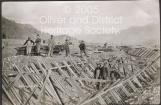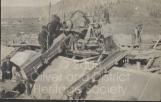1
Found in the Southern Okanagan Valley, Oliver is an oasis with rich agriculture and semi-arid beauty that has attracted tourists for decades. Truly one-of-a-kind in Canada, the hot summers and arid soils did not appear, at first, conducive to the orchards and vineyards of today.2
Sagebrush and Greasewood cover before widespread irrigation20th Century, Circa 1950's
Oliver, British Columbia, Canada
 Credits:
Credits:C. Scott Photography
SOLID
3
In the early years of European settlement, the Oliver area was home to ranchers hoping to exploit the plentiful, rich bunchgrass to develop a livestock market. However, the wealth was not to last. The 1800s were the end of a mini-ice age which had lowered temperatures, and increased annual precipitation during the ranching years (1860 - 1900). When the temperature began to rise and the precipitiation decreased, the ecosystem could not support the numbers of grazing cattle. Ranchers were forced to liquidate their holdings to developers whose investment would help to convert the fields into farmland. At that time, irrigation and infrastructure in the Oliver area were nearly non-existant, and agriculture remained a small-scale economy until the early 1920's.Major settlement began in 1918-1919, with the end of World War I and the passing of the Soldiers' Land Act. In a move to reintegrate returning veterans, the provincial government purchased nearly 9000 hectares of land along the Okanagan River to be distributed among the soldiers, with the intention of granting them the an opportunity to grow food for themselves and others, if they could not find other means of supporting their families.
4
Tent house and family20th Century, Circa 1920's
Oliver, British Columbia, Canada
 Credits:
Credits:Johnstone, James Cameron
5
Interview with Mrs. Elsie Boone conducted by Penny-Lynn Galbraith6 October 1983
Oliver, British Columbia, Canada
 Credits:
Credits:Galbraith, Penny-Lynn
Boone, Elsie
6
Tent Camp and Horses (present-day airport area)20th Century, Circa early 1920's
Oliver, British Columbia, Canada
 Credits:
Credits:Johnstone, James Cameron
7
Most of the settlers in the Oliver area were World War I veterans of British descent. Many of them were employed in work camps for the purpose of realizing the government-funded Southern Okanagan Lands Project. It was anticipated that the camp worker would save money for the purchase of subsidized land once the ditch was complete. The goal was to lay down twenty-five miles of irrigation backbone, including cement canalworks, raised flumes, and a huge underground siphon. The task was huge, the payoff viable farming land, and project in its entirety guaranteed work for the returned soldiers.8
Southern Okanagan Lands Project work camp20th century, Circa 1924
Oliver, British Columbia, Canada
 Credits:
Credits:McPherson, Alex
9
The canal, or "ditch", as it came to be called by locals, was to irrigate the land, starting north of Oliver, and ending at the Canada- US border. Vaseaux Lake, north of Oliver, was dammed, and the beginnings of the pivotal irrigation system were set into motion.10
Digging the ditch near McIntyre Bluff20th Century, Circa 1920's
Oliver, British Columbia, Canada
 Credits:
Credits:Johnstone, James Cameron
11
Near the dam at Vaseux Lake, which was named for Minister of Lands Thomas "Duff" Patullo, the ditch began eighteen and a half feet wide and five feet deep. When completed, it would be capable of delivering two-hundred and thirty cubic feet of water per second to all farms in the lower valley.12
Preparing to pour concrete20th Century, Circa early 1920's
Oliver, British Columbia, Canada
 Credits:
Credits:Johnstone, James Cameron
13
Because Vaseaux lake and its connecting rivers are fed by winter runoff, a number of spillways and reservoirs were constructed to help regulate the flow of water. When water flow was above average, the extra water was routed into reservoir tanks and manmade lakes. When these were filled, spillways directed excess water away from the canal and development, either to rejoin the Okanagan river, or soak into the ground.14
Southern Okanagan Lands Project workers pouring cement20th Century, Circa 1920's
Oliver, British Columbia, Canada
 Credits:
Credits:Johnstone, James Cameron